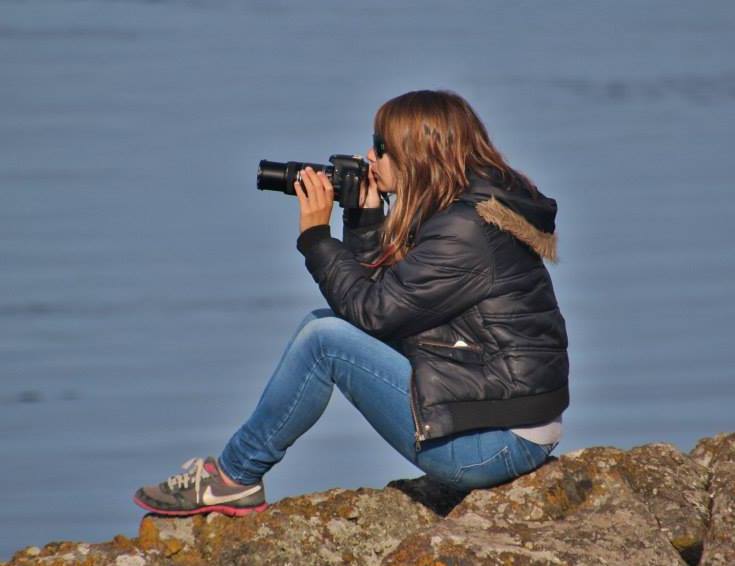The Odyssey witnessed a family reunion on April 8th. The T49As was slowly traveling past Saltspring Island and had just reunited with T49A1. T49A1 had split off from his mother and younger siblings late last year around the time of his newest sibling’s birth to travel with other matrilines. Siblings T49A1 and T49A3 were sticking to each other like glue while goofing off and paralleling the rest of the family. Towards the end of the encounter, T49A1 and T49A3 joined T49A, T49A4, and T49A5. Will T49A1 stay with his family or move on again? Time will tell.
On April 9th, the Odyssey spent some time with T49C and T65A3 as they traveled between Lopez and Decatur Islands. It was interesting to see young T65A3 away from his family and with T49C, a male who also travels away from his family. I wondered if T65A3 was away from his family because his mother was going to or already had a new calf. A few days later, T49C left the area and T65A3 was back with his family and there was a newborn calf with them! Just like T49A1, T65A3 split from his family when a new calf was born. Fascinating!
On April 18th, the Odyssey saw the T36As and T123s harassing birds off of East Point, Saturna Island. The whales were targeting long-tailed ducks and rhinoceros auklets. T36A3 likely killed a female long-tailed duck. We then got word of more whales nearby and headed down Boundary Pass to Blunden Island. It was the T49As again with T49A1 still in tow. The family was also heading toward East Point but was in no hurry to get there.
On April 19th, the Odyssey got to see the T49As again as they headed down Haro Strait. T49A1 and T49A3 were goofing off again out in front while T49A, T49A4, and T49A5 were trailing behind them. T49A and T49A4 then started playing with T49A5, lifting and tossing the calf into the air. T49A5 would go limp as it was lifted out of the water and even did a complete front flip during the highest toss. It looked a little rough but the calf seemed to be enjoying itself.
On April 26th, Dave Ellifrit and I had an encounter with Chainsaw T63 and his mother T65 in Georgia Strait. The two were slowly traveling west for most of the encounter but then started charging north. It appeared that they had heard other transients vocalizing in the area and were eager to get to them. This was my first time seeing Chainsaw after eight long years of waiting! The encounter summary can be viewed on the Center for Whale Research 2018 encounters page.
On April 28th, the Odyssey witnessed something different. While nearing spread out social groups of transients by Patos Island, males T101A, T101B, and T102 split off from T101, the T100s, and the T100Bs and started porpoising east toward the T36As and T123s. The T36As and T123s were attacking a sea lion but left it and porpoised away from the three males. The T36As and T123s gave the males a wide girth and headed east, then north in a tight group. The males stopped and slowly headed west back towards T101, the T100s, and T100Bs. I had never seen transients avoid each other before and it was weird for these individuals to avoid each other in particular since they have been seen socializing together many times before. I wondered if T36A or T123 was pregnant and close to giving birth. The evasive behavior reminded me of the behavior described in the recent discovery of killer whale infanticide.
On May 5th, the Odyssey encountered the T90s in Boundary Pass. They were accompanied by a female known as T2B. The whales were slowly zig-zagging toward Patos Island, pushing against the ebbing tide. This was my first time seeing the T90s and it was great to meet T90, a survivor of a satellite tag gone wrong. It was also awesome to see that T90B’s dorsal fin is starting to sprout.
On May 6th, I witnessed my first harbor porpoise kill while aboard the Odyssey. The T100s and T123s were sleepily traveling down Boundary Pass and had been down on a deep dive when a few of the whales erupted from the water and chased after an unlucky harbor porpoise. Both matrilines were involved in the chase at first but then everyone moved off to the side except for T123 and T123C.
Young T123C did most of the chasing and ramming until the porpoise was exhausted. It appeared that T123 was teaching porpoise hunting techniques to T123C. T123 then took over and finished off the porpoise. T123 took the porpoise over to the others, who had been milling and celebrating. After a bit of time feeding underwater, the T100s and T123s continued to celebrate their kill with breaches, tail slaps, dorsal fin slaps, cartwheels, and spy hops. A chunk of the harbor porpoise was seen in T123A’s mouth as he swam past.
What will happen next?!
Please do not use my photos without my permission. Just ask.
